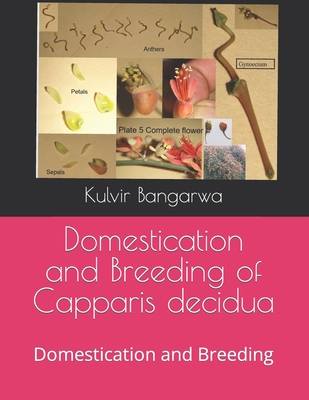You are here
Back to topDomestication and Breeding of Capparis decidua: Domestication and Breeding (Paperback)
$11.49
Usually Ships in 1-5 Days
(This item cannot be returned.)
(This item cannot be returned.)
Description
The project work on "Plant Diversity Assessment and Establishment of Germplasm Bank for Conservation, Domestication, and Breeding in Capparis decidua" under Dr. B.P.Pal National Environment Fellowship Award for Biodiversity was started in December 2008 for two years for the assessment of plant diversity, rate of loss in plant diversity and causes for the decline in biodiversity of Capparis decidua, documentation of traditional knowledge, folk varieties, and other notable material, identification of promising reproductive material of Capparis decidua from different fragile environmental conditions, the establishment of germplasm bank of Capparis decidua and domestication and breeding of Capparis decidua.
A survey of southern Haryana and Rajasthan was conducted during flowering and fruiting seasons. Capparis decidua has its existence in undisturbed areas. Salvadora oleoides has been very closely associated with the tree species of Capparis decidua. Prosopis cineraria, Azadirachta indica, and Calotropis procera were also observed to be associated species. Prosopis juliflora (which regenerates faster and grows aggressively) has become a serious threat to the existence of our indigenous plants/trees and Capparis decidua is a serious victim of Prosopis juliflora.
Flowering and fruiting in Capparis decidua have been observed twice a year. A lot of variation was observed for flowering and fruiting between regions and between plants within the region. The flowers of Capparis decidua were observed to be complete having all the four parts viz., calyx (four sepals), corolla (four petals), androecium (many stamens usually 13-16 with a length varies from 0.5 to 1.2 cm), and gynoecium (ovary superior, bicarpellary syncarpous, unilocular with many ovules arranged on parental placenta, style absent and stigma about 1.1 cm.). In Capparis decidua stigma is closely surrounded by anthers. Pollination may be before flower opening or after flower opening. But the position of anthers in relation to stigma seems to ensure self-pollination. The seeds of Capparis decidua showed a lot of variation for seed germination (fresh seeds) ranging from zero percent to 63.89%.
Capparis decidua has proven to be an economically important plant in southern Haryana, Rajasthan, and elsewhere. It provides varied food and medicinal uses, building materials, fuelwood, and other income-generating opportunities. It contributes to environmental sustainability due to its soil-binding capacity and its ability to improve the soil fertility of sand dunes and to reduce soil alkalinity. For large-scale plantation of Capparis decidua, it has been established that Capparis decidua can be successfully grown from seeds and suckers. Its matured fruits which have turned pink should be collected either in May-June or August-October. Seeds should be separated out by washing the pulp of fruits within 2-3 days. Seeds are to be sown in polythene bags (with a 3:1 ratio of sandy soil and FYM) in August if seeds are collected in May-June or February if seeds are collected in August-October. Collection of seeds in August-October and sowing of seeds in early February are desirable. Transplanting of seedlings should be done in early February by choosing seedlings of more than 15 cm height. Suckers of Capparis decidua are to be collected in early February and should be established in polythene bags (with a 3:1 ratio of sandy soil and FYM). Plants raised from suckers attain usually attain a height of more than 15 cm in 4-5 months and hence these plants are transplanted in the field during the rainy season.
